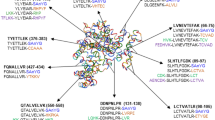Abstract
The accurate determination of protein concentration is an important though non-trivial task during the development of a biopharmaceutical. The fundamental prerequisite for this is the availability of an accurate extinction coefficient. Common approaches for the determination of an extinction coefficient for a given protein are either based on the theoretical prediction utilizing the amino acid sequence or the photometric determination combined with a measurement of absolute protein concentration. Here, we report on an improved SV-AUC based method utilizing an analytical ultracentrifuge equipped with absorbance and Rayleigh interference optics. Global fitting of datasets helped to overcome some of the obstacles encountered with the traditional method employing synthetic boundary cells. Careful calculation of dn/dc values taking glycosylation and solvent composition into account allowed the determination of the extinction coefficients of monoclonal antibodies and an Fc-fusion protein under native as well as under denaturing conditions. An intra-assay precision of 0.9% and an accuracy of 1.8% compared to the theoretical value was achieved for monoclonal antibodies. Due to the large number of data points of a single dataset, no meaningful difference between the ProteomeLab XL-I and the new Optima AUC platform could be observed. Thus, the AUC-based approach offers a precise, convenient and versatile alternative to conventional methods like total amino acid analysis (AAA).

Similar content being viewed by others
References
Anders JC, Parten BF, Petrie GE, Marlowe RL, McEntire JE (2003) Using amino acid analysis to determine absorptivity constants. Biopharm Int 2:30
Babul J, Stellwagen E (1969) Measurement of protein concentration with interferences optics. Anal Biochem 28:216–221. https://doi.org/10.1016/0003-2697(69)90172-9
Balbo A, Minor KH, Velikovsky CA, Mariuzza RA, Peterson CB, Schuck P (2005) Studying multiprotein complexes by multisignal sedimentation velocity analytical ultracentrifugation. Proc Natl Acad Sci USA 102:81–86. https://doi.org/10.1073/pnas.0408399102
Bartolomeo MP, Maisano F (2006) Validation of a reversed-phase HPLC method for quantitative amino acid analysis. J Biomol Tech 17:131–137
Brautigam CA (2015) Calculations and publication-quality illustrations for analytical ultracentrifugation data. In: Cole JL (ed) Methods in enzymology, vol 562. Academic Press, pp 109–133. doi:https://doi.org/10.1016/bs.mie.2015.05.001
Carlstedt I, Lindgren H, Sheehan JK (1983) The macromolecular structure of human cervical-mucus glycoproteins. Studies on fragments obtained after reduction of disulphide bridges and after subsequent trypsin digestion. Biochem J 213:427–435
Edelhoch H (1967) Spectroscopic determination of tryptophan and tyrosine in proteins. Biochemistry 6:1948–1954. https://doi.org/10.1021/bi00859a010
Gasteiger E, Hoogland C, Gattiker A, Duvaud Se, Wilkins MR, Appel RD, Bairoch A (2005) Protein identification and analysis tools on the ExPASy server. In: Walker JM (ed) The proteomics protocols handbook. Humana Press, Totowa, pp 571–607. doi:https://doi.org/10.1385/1-59259-890-0:571
Gill SC, von Hippel PH (1989) Calculation of protein extinction coefficients from amino acid sequence data. Anal Biochem 182:319–326. https://doi.org/10.1016/0003-2697(89)90602-7
Gray RA, Stern A, Bewley T, Shire SJ (1995) Rapid Determination of Spectrophotometric Absorptivity by Analytical Ultracentrifugation. Beckman Instruments Inc, Fullerton, CA
Kendrick BS, Kerwin BA, Chang BS, Philo JS (2001) Online size-exclusion high-performance liquid chromatography light scattering and differential refractometry methods to determine degree of polymer conjugation to proteins and protein-protein or protein-ligand association states. Anal Biochem 299:136–146. https://doi.org/10.1006/abio.2001.5411
Kohno T, Tam L-TT, Stevens SR, Louie JS (2007) Binding characteristics of tumor necrosis factor receptor-Fc fusion proteins vs anti-tumor necrosis factor mAbs. J Investig Dermatol Symp Proc 12:5–8. https://doi.org/10.1038/sj.jidsymp.5650034
Laue TM, Shah BD, Ridgeway TM, Pelletier SL (1992) Computer-aided interpretation of analytical sedimentation data for proteins. In: Harding SE, Rowe AJ, Horton JC (eds) Analytical Ultracentrifugation in Biochemistry and Polymer Science. Royal Society of Chemistry, Cambridge, pp 90–125
Lee JC, Timasheff SN (1979) The calculation of partial specific volumes of proteins in 6 M guanidine hydrochloride. In: Methods in enzymology, vol 61. Academic Press, pp 49–57. doi:https://doi.org/10.1016/0076-6879(79)61006-6
Miranda-Hernández MP, Valle-González ER, Ferreira-Gómez D, Pérez NO, Flores-Ortiz LF, Medina-Rivero E (2016) Theoretical approximations and experimental extinction coefficients of biopharmaceuticals. Anal Bioanal Chem 408:1523–1530. https://doi.org/10.1007/s00216-015-9261-6
Noble JE, Knight AE, Reason AJ, Di Matola A, Bailey MJA (2007) A comparison of protein quantitation assays for biopharmaceutical applications. Mol Biotech 37:99–111. https://doi.org/10.1007/s12033-007-0038-9
Noelken ME, Timasheff SN (1967) Preferential solvation of bovine serum albumin in aqueous guanidine hydrochloride. J Biol Chem 242:5080–5085
Nozaki Y (1972) The preparation of guanidine hydrochloride. In: Methods in enzymology, vol 26. Academic Press, pp 43–50. doi:https://doi.org/10.1016/S0076-6879(72)26005-0
Pace CN, Vajdos F, Fee L, Grimsley G, Gray T (1995) How to measure and predict the molar absorption coefficient of a protein. Protein Sci 4:2411–2423. https://doi.org/10.1002/pro.5560041120
Rutherfurd SM, Dunn BM (2001) Quantitative amino acid analysis. In: Current protocols in protein science. Wiley. doi:https://doi.org/10.1002/0471140864.ps0302s63
Schuck P (2000) Size-distribution analysis of macromolecules by sedimentation velocity ultracentrifugation and Lamm equation modeling. Biophys J 78:1606–1619. https://doi.org/10.1016/S0006-3495(00)76713-0
Strauss HM, Karabudak E, Bhattacharyya S, Kretzschmar A, Wohlleben W, Cölfen H (2008) Performance of a fast fiber based UV/Vis multiwavelength detector for the analytical ultracentrifuge. Colloid Polym Sci 286:121–128. https://doi.org/10.1007/s00396-007-1815-5
Zhao H, Brown Patrick H, Schuck P (2011) On the distribution of protein refractive index increments. Biophys J 100:2309–2317. https://doi.org/10.1016/j.bpj.2011.03.004
Zhao H et al (2012) Analysis of high-affinity assembly for AMPA receptor amino-terminal domains. J Gen Physiol 139:371–388. https://doi.org/10.1085/jgp.201210770
Author information
Authors and Affiliations
Corresponding author
Ethics declarations
Conflict of interest
All authors are or have been employees of HEXAL AG. None of the authors owns stock of HEXAL AG (Novartis).
Additional information
Special Issue: 23rd International AUC Workshop and Symposium.
Electronic supplementary material
Below is the link to the electronic supplementary material.
Rights and permissions
About this article
Cite this article
Hoffmann, A., Grassl, K., Gommert, J. et al. Precise determination of protein extinction coefficients under native and denaturing conditions using SV-AUC. Eur Biophys J 47, 761–768 (2018). https://doi.org/10.1007/s00249-018-1299-x
Received:
Revised:
Accepted:
Published:
Issue Date:
DOI: https://doi.org/10.1007/s00249-018-1299-x




